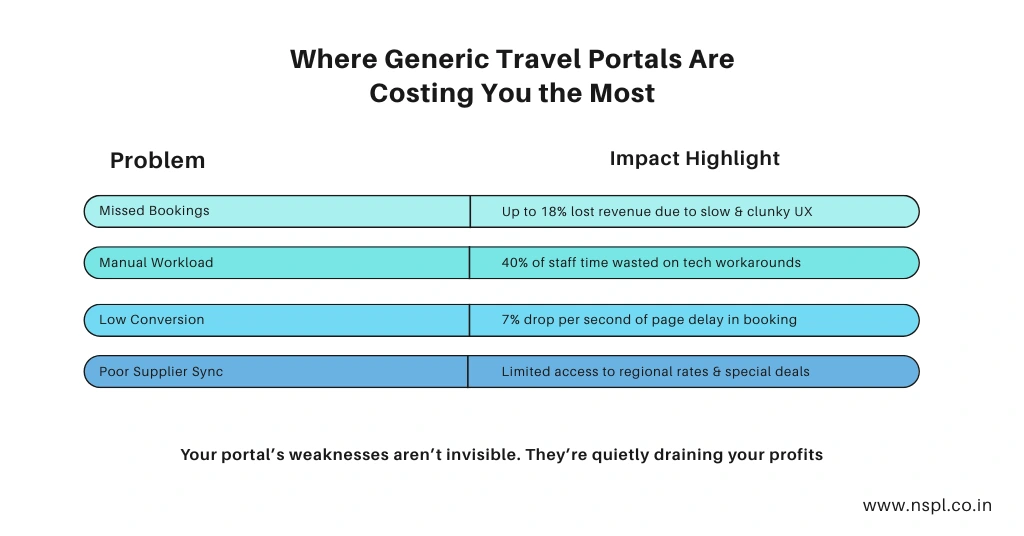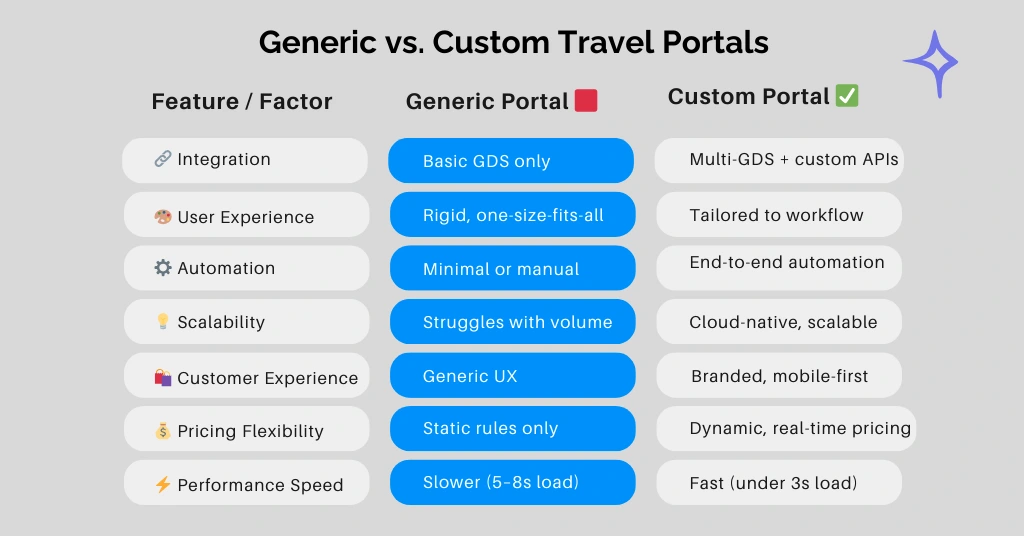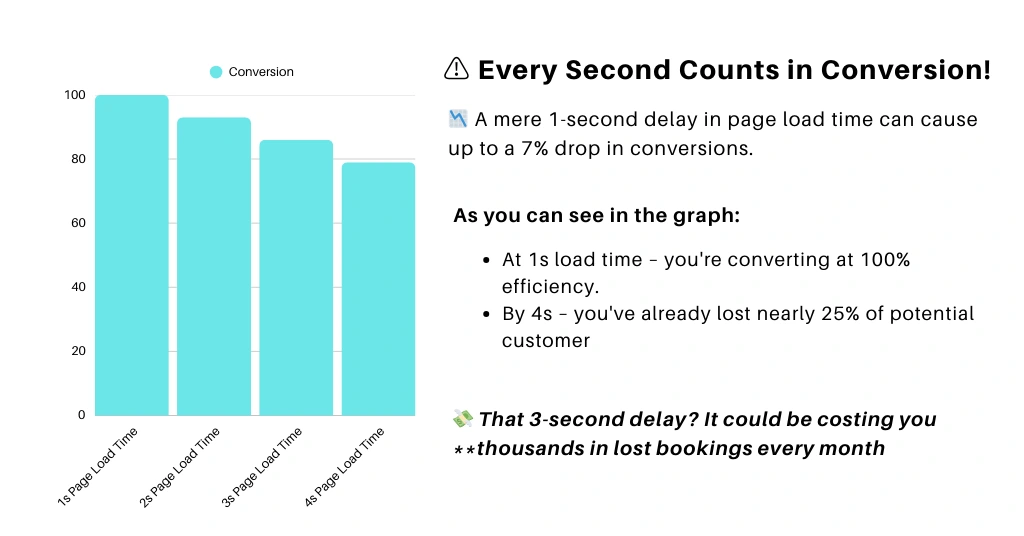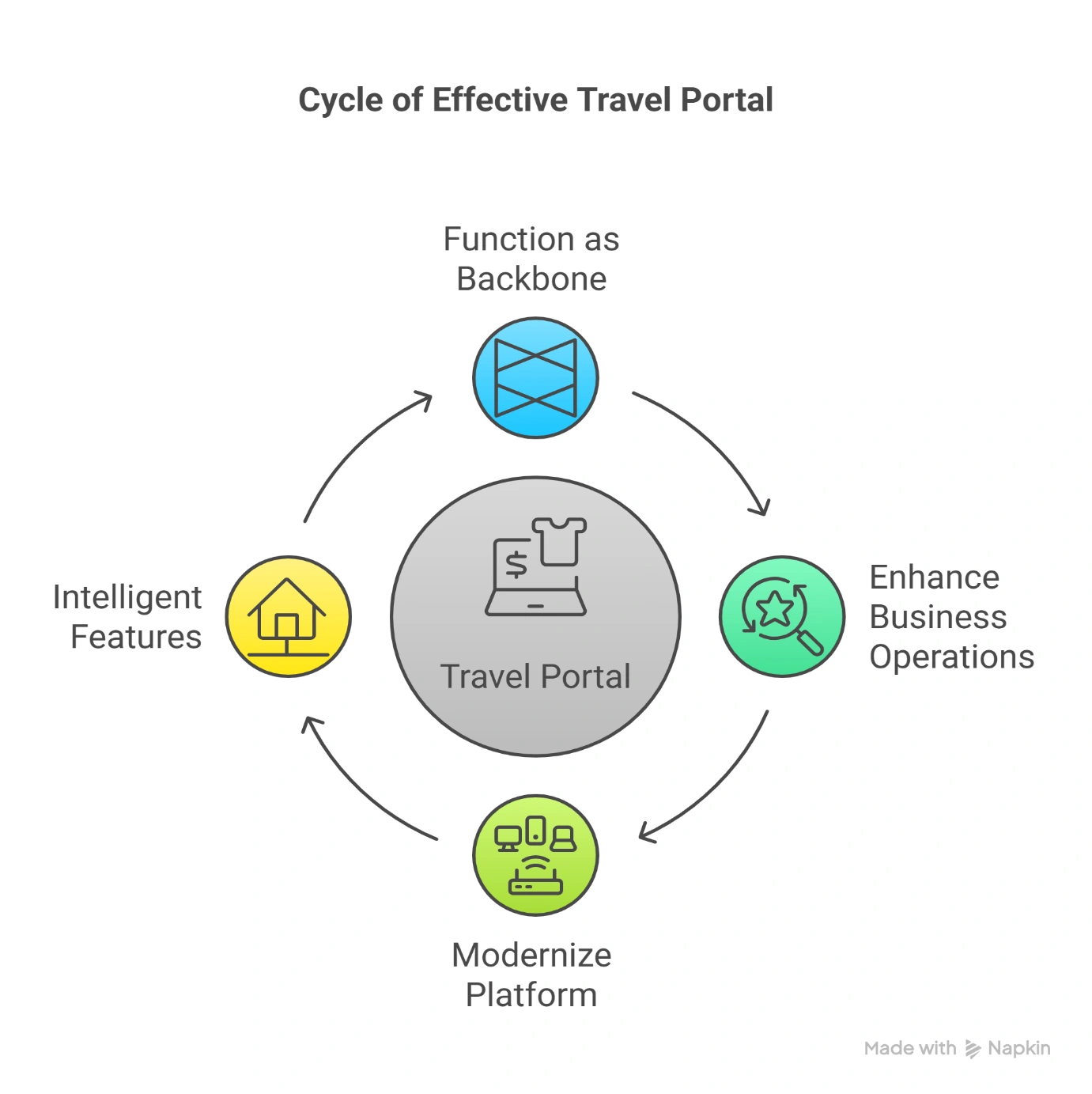Table of contents
Why Generic Travel Portals Are Holding Your Business Back: A Better Way Forward
Every day your travel business operates with a generic portal, you’re leaving money on the table. Not in small amounts, but in significant revenue that silently bleeds from your operation with each missed booking, confused customer, and operational inefficiency.
As someone who has guided dozens of travel businesses through digital transformations, I’ve seen the same pattern repeat: companies settle for “good enough” technology until they realize it’s actually been their biggest growth bottleneck all along.
The Hidden Cost of "Good Enough" Technology
Imagine this: Your staff spends hours double- and triple-checking bookings due to your portal not syncing with suppliers. Your customers abandon bookings because the user interface is slow and outdated. Your margins go down the drain because you cannot implement dynamic pricing strategies fast enough to stay competitive.
These aren’t minor inconveniences—they’re existential threats to your business.

One mid-sized travel agency I consulted with discovered they were losing approximately 18% of potential bookings due to technical limitations of their off-the-shelf portal. Another found their operational staff spending nearly 40% of their time compensating for technology shortcomings rather than serving customers.
Why Generic Portals Fall Short

Let’s break down where generic solutions fall behind across the core pillars of performance.
1. Limited Integration Capabilities
Generic portals typically offer basic GDS integration that covers only mainstream providers. This leaves you unable to access specialized inventory or negotiate preferred rates with regional suppliers—a critical competitive advantage in today’s market.
2. Rigid User Experience
Off-the-shelf solutions make your company adapt to their system instead of accommodating your individual workflow. This introduces friction points for both your customers and employees, which lead to increased training time, more mistakes, and greater abandonment rates.
3. Poor Scalability
Most generic portals perform adequately at low volumes but buckle under pressure when your business grows. This performance degradation typically happens at the worst possible time—when you’re experiencing growth and trying to capitalize on momentum.
4. Cookie-Cutter Customer Experience
In today’s market, differentiation is everything. Generic portals force you into the same customer experience template as thousands of other travel businesses, making it nearly impossible to build brand loyalty or command premium pricing.
The Price You're Actually Paying
- Lost direct bookings: Studies show that for every one-second delay in page load time, conversions drop by 7%. Most generic portals load significantly slower than custom solutions.

A 1-second delay can cost you 7% of your sales. At 4 seconds, you’re losing almost a quarter of your potential revenue. This isn’t just about speed—it’s about serious business performance.
- Higher acquisition costs: When your conversion rate suffers, your marketing costs effectively increase—you’re paying more to acquire each successful booking.
- Operational inefficiency: Manual workarounds and process hacks to compensate for portal limitations translate to higher labor costs and more errors.
- Opportunity cost: While you struggle with technical limitations, your competitors with optimized systems are innovating and capturing market share.
What a Great Travel Portal Should Deliver

1. Smooth Multi-GDS Integration
Your portal needs to integrate easily with all top GDSs and supplier direct APIs, and display consolidated inventory without the underlying technical complexity reflected to users.
2. Dynamic Pricing Intelligence
Modern travel businesses need the ability to implement sophisticated pricing strategies in real-time, including mark-up rules, promotional discounts, and personalized offers.
3. Lightning-Fast Performance
Your portal’s response time for a search should ideally be less than 3 seconds, even on complex multi-city itineraries with multiple criteria. This has a direct influence on conversion rates and customer satisfaction.
4. Workflow Automation
Each human touch point within your booking process is both a cost of labor and a point of potential error. Advanced portals automate repetitive tasks such as confirmation emails, payment reconciliation, and notifications to suppliers.
5. Mobile-First Design
With mobile bookings accounting for over 50% of travel transactions in many markets, your portal must deliver a seamless experience across all devices—not just a functional but subpar mobile experience.
6. Scalable Architecture
Your technology should support your business growth, not constrain it. This means cloud-based infrastructure that can handle peak loads without performance degradation.
The Path Forward: Custom vs. Generic
The argument between generic and custom solutions really boils down to business strategy. If you see your web portal as nothing more than a cost center, a generic solution may be good enough. But if you see it as a strategic asset and possible competitive edge, customization is necessary.
Top travel companies are increasingly turning to specialized travel portal development company in India that combine technical capabilities with deep industry knowledge to create solutions perfectly aligned with their operational models, target markets, and growth trajectories.
Taking the Next Step
If you find that your current portal is causing more problems than it is solving, you might want to consider the following:
- Audit your current process: Document exactly where technical limitations are creating friction in your customer journey and operational workflow.
- Quantify the impact: Calculate the actual cost of workarounds, manual processes, and lost conversions.
- Explore modern options: The landscape of travel technology has evolved dramatically in recent years, with modular solutions that offer customization without starting from scratch.
- Prioritize strategically: Focus first on the technical limitations that directly impact revenue and customer experience.
Conclusion
Your travel portal isn’t just another business expense—it’s the digital foundation of your entire operation. As travel markets become increasingly competitive, the businesses that thrive will be those that recognize technology as a strategic differentiator rather than a necessary evil.
The question isn’t whether you can afford to upgrade from a generic portal. It’s whether you can afford not to.
Is your travel business ready for a technology partner who understands the unique challenges you face? Consider exploring custom travel portal development options that align with your specific business model and growth objectives.

